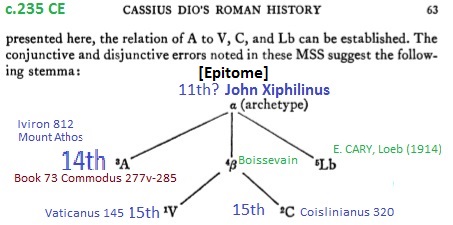
 |
Freethought & Rationalism ArchiveThe archives are read only. |
|
|
#161 | |||
|
Contributor
Join Date: Mar 2006
Location: Falls Creek, Oz.
Posts: 11,192
|
The monastery at Mount Athos is not shut off from the rest of the world.
On Mount Athos and Its Monasteries; With Notes on the Route from Constantinople to Saloniki, in June, 1836 by Webber Smith The author left Constantinople on May 17th 1836 and arrived at the Iviron Monastery on Mount Athos on May 31st of the same year, a journey of two weeks. Quote:
|
|||
|
|
|
|
#162 | |
|
Veteran Member
Join Date: Jun 2010
Location: seattle, wa
Posts: 9,337
|
Quote:
|
|
|
|
|
|
#163 | |||
|
Contributor
Join Date: Mar 2006
Location: Falls Creek, Oz.
Posts: 11,192
|
Quote:
http://www.jstor.org/stable/1087381 The Mount Athos Epitome of Cassius Dio's Roman History B. C. Barmann Phoenix > Vol. 25, No. 1, Spring, 1971 p.61 Quote:
|
|||
|
|
|
|
#164 | |||
|
Contributor
Join Date: Mar 2006
Location: Falls Creek, Oz.
Posts: 11,192
|
Quote:
It looks to be a quicker and shorter journey between the two locations by sea. http://www.ouranoupoli.com/athos/athos.html Quote:
|
|||
|
|
|
|
#165 |
|
Veteran Member
Join Date: Jun 2010
Location: seattle, wa
Posts: 9,337
|
But what is the point of all this. It is well established that the manuscript of the Philosophumena was buried somewhere in an already a remote and difficult to access monastery. All evidence points to the author of the epitome of Dio Cassius (a) never having read the Philosophumena (b) never having set foot in Mount Athos and (c) much of the other material related to Dio Cassius especially the later books is also an epitome. So where is the 'there there'? There is no reason to think that the epitome was influenced by the Philosophumena. The stories are completely different. You aren't just accusing the epitome of 'copying' the Philosophumena because it clearly isn't a copy of the information. You have to be suggesting that the person writing the epitome:
1. came to Mount Athos 2. found this obscure manuscript that no one had ever heard of 3. read the story about Marcia (which is buried in a later chapter which is particularly difficult for Christians to swallow, not only because they are identifying a harlot as a Christian but insulting a third century bishop of Rome) 4. after reading the story of Marcia being a Christian he went back to Constantinople and made up stuff wholly from his own imagination reinforcing the claim that Marcia was a Christian. But why? How does any of this seem remotely plausible or better yet a better explanation of the phenomenon than these are two separate testimonies to the same thing - i.e. Marcia being a Christian. Also even with all this bullshit you still have the Philosophumena's original testimony (i.e. Marcia is still said to be a Christian in the Philosophumena) , Eusebius's statement that the rule of Commodus was a golden age for Christians and Irenaeus's statement that Christians were popular at the Imperial court of Commodus. I don't see how you keep at this nonsense. Your explanation is hilariously dishonest . |
|
|
|
|
#166 | ||||||
|
Contributor
Join Date: Mar 2006
Location: Falls Creek, Oz.
Posts: 11,192
|
Quote:
A superior copy of the epitome of John Xiphilinus was also found at a Mount Athos monastery. See post #163 Quote:
And BTW ..... Quote:
An invite from the de-facto wife of the emperor Commodus to a bishop (or a anyone else) would have been prestigious. Quote:
Quote:
The text of the epitome of Book 73 on the net cited by Toto seems to be the translation of Cary, derived from ..... Quote:
|
||||||
|
|
|
|
#167 |
|
Veteran Member
Join Date: Jun 2010
Location: seattle, wa
Posts: 9,337
|
You have not produced a reasonable argument to reject the testimony of two ancient texts that Marcia was a Christian or friendly towards Christianity. You still have produced nothing whatsoever to contract the assumption that develops from the EXPLICIT testimony of these two ancient documents (and IMPLICITLY in several others) that Christians was an active influential religion as early as 180 CE. As such your theory is that kaput. Bye bye
|
|
|
|
|
#168 |
|
Veteran Member
Join Date: Jun 2010
Location: seattle, wa
Posts: 9,337
|
'contract' above should read 'contradict'
|
|
|
|
|
#169 | |
|
Contributor
Join Date: Feb 2006
Location: the fringe of the caribbean
Posts: 18,988
|
Quote:
The term 'Christian' is ambiguous and was applied to many persons, cults and even Jews who rejected the story and blasphemed the name of Jesus. It was the epitomizer who deliberately added claims about "Christians" not found in the original "Roman History" . The single mention of the word "Christians" in Roman History tells us nothing about Jesus cult Christians unless you are putting forward the absurd notion that all 'Christians' at the time of Commodus were of the Jesus cult. |
|
|
|
|
|
#170 | ||
|
Contributor
Join Date: Mar 2006
Location: Falls Creek, Oz.
Posts: 11,192
|
Quote:
 On the LHS manuscript A represents the manuscript of the epitome of John Xiphilinus found in the Mount Athos monastery c.1900, fifty years after the manuscript (14th century) of the Philosophumena was also found in a Mount Athos monastery. The text of Book 73 under discussion (translated by Carey for Loeb) is sourced from V and C. It would be interesting to see what the text of A reads at the same place. According to the article cited above, the rule of Commodus is presented in this manuscript A at folios 277v-285v. |
||
|
|
| Thread Tools | Search this Thread |
|